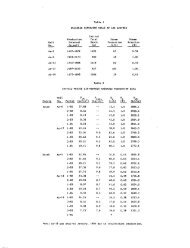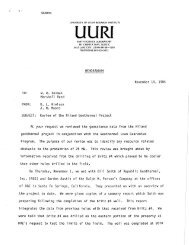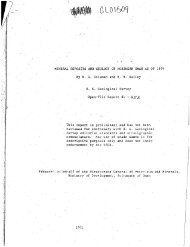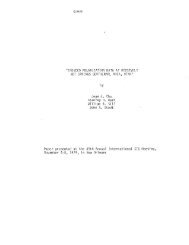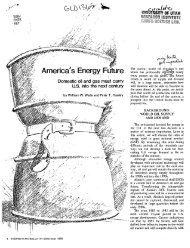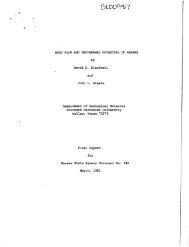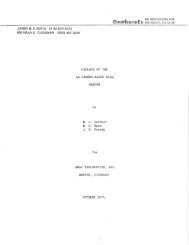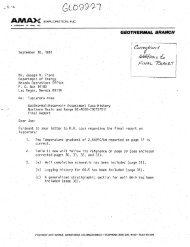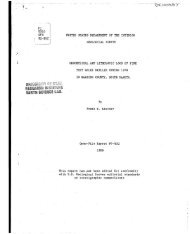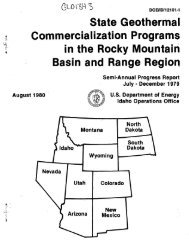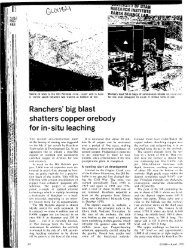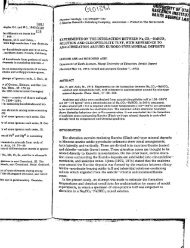Management Model for Power Production From ... - University of Utah
Management Model for Power Production From ... - University of Utah
Management Model for Power Production From ... - University of Utah
Create successful ePaper yourself
Turn your PDF publications into a flip-book with our unique Google optimized e-Paper software.
EXAMPLE<br />
A hypothetical geothermal reservoir is developed <strong>for</strong><br />
electrical power production. Hot water is extracted from the<br />
reservoir, used to generate electrical power by the direct<br />
method, and reinjected into the reservoir. The characteristics<br />
<strong>of</strong> the reservoir and power plant are presented in the<br />
following sections.<br />
The Reservoir<br />
A vertical cross-sectional view <strong>of</strong> a hypothetical hot water<br />
geothermal reservoir is shown in Figure 4. The reservoir is<br />
an aquifer (composed <strong>of</strong> porous material) that is bounded<br />
above by a relatively impermeable layer and is bounded<br />
below by a confining layer capable <strong>of</strong> vertical ,leakage. The<br />
aquifer is 500 m in thickness and the lowef confining layer is<br />
assumed to be semi-infinite in thickness. There is a thick<br />
layer <strong>of</strong> surface material above the confining layer that does<br />
not interact in any fashion with the aquifer. The aquifer<br />
underlies an area <strong>of</strong>7.2 x 10 7 m 2 • The area is rectangular in<br />
shape with north-to-south dimensions <strong>of</strong> 9000 m and east-towest<br />
dimensions <strong>of</strong> 8000 m. The aquifer's porosity and<br />
intrinsic permeability are 0.2 and 0.1 x 10- 9 cm 2 , respectively.<br />
The compressibility coefficient <strong>of</strong> water is taken to be<br />
0.768 x 10- 10 cm 2 /dyne.<br />
Figure 5 presents the vertically averaged temperature<br />
distribution within the aquifer. Temperatures range from<br />
50°C to 230°C. Figure 6 presents the initial pressure distribution,<br />
based on a reference level near the top <strong>of</strong> the reservoir,<br />
which ranges from 1.15 x 10 8 dyne/cm 2 to 1.60 x 10 8 dyne/<br />
cm. Using (I) to calculate the viscosity distribution, (2) to<br />
calculate the initial density distribution, the transmissive<br />
quality and storage quality distributions are calculated using<br />
(10) and (II), respectively. Figure 7 presents the transmis-<br />
MADDOCK ET AL.: GEOTHERMAL POWER, I<br />
Fig. 6. Initial pressure distribution, dyne/cm 2 x 106, at a reference<br />
level near the top <strong>of</strong> the reservoir.<br />
sive quality distribution while Figure 8 presents the storage<br />
distribution.<br />
The semi-infinite leaky layer is composed <strong>of</strong> homogeneous<br />
material and has a hydraulic conductivity <strong>of</strong> 1.0 x 10- 8 cmls<br />
and a specific storage <strong>of</strong> 0.1 x 1O- 7 /cm.<br />
A finite-difference technique [Maddock, 1974] is used to,<br />
calculate values· <strong>of</strong> R(k, j; " by superimposing a 72 node,<br />
Fig. 5. Vertically averaged temperature distribution, °C (averaged Fig. 7. Distribution over the reservoir <strong>of</strong> the transmissive quality,<br />
over the reservoir thickness), <strong>for</strong> the reservoir. em s x 10- 8<br />
•<br />
505
MADDOCK ET AL.: GEOTHERMAL POWER, I 507<br />
TABLE I. Response Functions <strong>for</strong> Site I (ltcm s)<br />
Year (n) R(I,I,n) R(I, 2, n) R(I, 3, n) RO, 4, n) R(I, 5, n)<br />
I 184.221 88.0797 107.9536 69.3484 76.6602<br />
2 67.3156 63.1493 64.6223 60.5776 61.6929<br />
3 58.8358 58.0890 58.3932 57.6123 57.8825<br />
4 56.9865 56.7217 56.8383 56.5903 56.6886<br />
5 56.1180 56.0089 56.0605 55.9638 56.0069<br />
6 55.4962 55.4495 55.4729 55.4325 55.4528<br />
7 54.9679 54.9477 54.9581 54.9411 54.9507<br />
8 54.4902 54.4816 54.4859 54.4793 54.4837<br />
9 54.0473 54.0440 54.0454 54.0434 54.0452<br />
10 53.6319 53.6309 53.6308 53.6309 53.6315<br />
II 53.2392 53.2392 53.2385 53.2394 53.2394<br />
12 52.8660 52.8665 52.8655 52.8668 52.8664<br />
J3 52.5100 52.5106 52.5095 52.5109 52.5104<br />
14 52.1691 52.1698 52.1686 52.1701 52.1696<br />
15 51.841& 51.8426 51.8414 51.8428 51.8423<br />
16 51.5269 51.5276 51.5265 51.5279 51.5274<br />
17 51.2231 51.2227 51.2227 51.2241 51.2236<br />
18 50.9296 50.9303 50.9292 50.9306 50.9301<br />
19 50.6455 50.6462 50.6452 50.6465 50.6460<br />
20 50.3701 50.3708 50.3698 50.3710 50.3706<br />
Only response functions <strong>for</strong> extraction wells are listed.<br />
eight injection wells. The extraction and injection rates are<br />
given in columns 15 through 23. In the second construction<br />
interval, one additional high pressure and one additional low<br />
pressure turbine are added giving a rated total capacity <strong>of</strong> 27<br />
MW. The plant actually generates 23.3 MW. Two extraction<br />
wells are added but the number <strong>of</strong> injection wells remains<br />
unchanged. In the third construction interval one high pressure<br />
turbine is added giving a rated total capacity <strong>of</strong> 29 MW.<br />
Site 4 is developed and the third construction interval<br />
injection well is added at site 8 and 12. No additional wells<br />
are added at site 3; the plant generates 28.9 MW. In the final<br />
construction interval, no additional power plant and well<br />
capacity is added. The actual power generated drops from<br />
28.9 to 23.2 MW. The gradual rise then sudden drop in power<br />
production is due to the single phase flow constraint. For<br />
unrestricted recharge <strong>of</strong> available water after a 15% loss <strong>of</strong><br />
fluid, over 403,000 gal <strong>of</strong> water at 85°C is reinjected from the<br />
sixth through the tenth time periods. Large injections <strong>of</strong><br />
lower temperature fluid could reduce the temperature distribution<br />
throughout the reservoir (even though the reservoir<br />
remains single phase), thus violating the constant temperature<br />
assumption. To determine temperature changes pro-'<br />
duced by the extraction and injection values <strong>for</strong> the 15%<br />
loss, tests were made using a temperature-pressure single<br />
phase model [Mercer et al., 1975J. It was found that the<br />
maximum temperature changes were less than 2°C. Hence<br />
TABLE 2. Initial Conditions <strong>for</strong> <strong>Power</strong> Plant (Exogenous Variables)<br />
the constant temperature assumption is not violated to a<br />
degree to warrant modeling <strong>of</strong> temperature variation.<br />
CONCLUSIONS<br />
Three assumptions concerning the reservoir model provide<br />
the linear <strong>for</strong>m <strong>of</strong> the equation <strong>of</strong>flow (equation (9»: the<br />
reservoir contains only pure water; the reservoir is liquid<br />
dominated; and the spatial distribution <strong>of</strong> temperature <strong>for</strong><br />
the reservoir is known and invarient with time. If any <strong>of</strong><br />
these assumptions are invalid <strong>for</strong> application to a geothermal<br />
reservoir, the flow equation may become coupled with an<br />
additional equation relating . changes in concentration,<br />
changes in phase, or changes in temperature due to withdrawals.<br />
This coupling is generally nonlinear.<br />
If concentrations <strong>of</strong> dissolved solids are greater than 2%<br />
by weight, the thermodynamic equations «1) and (2» may<br />
require modification such that the viscosity and density<br />
become dependent on concentration. If concentrations are<br />
assumed to be uni<strong>for</strong>m throughout the reservoir, withdrawals<br />
will not induce changes in concentrations and (9) is still a<br />
valid approximation. However, if the concentrations are<br />
nonhomogeneous; withdrawals will induce changes in the<br />
concentrations, and the flow equation is coupled via the<br />
velocity field, to an equation describing the rate <strong>of</strong> change <strong>of</strong><br />
concentrations (<strong>for</strong> example, see INTERCOMP [1976]).<br />
If fluid in the reservoir undergoes a change from single<br />
Liquid Vapor Liquid Vapor<br />
Pressure, Enthalpy, Enthalpy, Entropy, Entropy,<br />
dynetcm 2 erg/g erg/g erg/g °C erg/g °C<br />
After primary 1.256 x 10 7 (PI) 8.053 x 10 9 2.786 X 1010 2.231 X 10 7 6.512 x W<br />
separator-flasher<br />
Into low pressure 3.495 x 10 6 (P 2 ) 5.818 x 10 9 2.548 X 1010 1.722 X 10 7 6.945 X 10 7<br />
turbine<br />
I nto back compressor 2.026 x 10 5 (P 3 ) 2.514 x 10 9 2.457 X 1010 8.320 X 10 6 7.908 X 10 7<br />
At atmospheric 1.013 x 10 6 (P a ) 4.174 X 10 9 2.506 X 1010 1.303 X 10 7 7.359 X 10 7<br />
Out <strong>of</strong> dump 3.000 x 10 9<br />
condenser<br />
Efficiencies (mechanical .... electrical): high pressure turbine, 0.85; low pressure turbine, 0.65; back compressor, 0.85.
ewritten as<br />
MADDOCK ET AL.: GEOTHERMAL POWER,<br />
(A5)<br />
where 'TIs is the isentropic efficiency <strong>for</strong> the turbine (which<br />
has been specified, by assumption). Thus<br />
h/ = hl - 'TI.(hl - hl)<br />
The steam fraction at the outlet is obtained as<br />
T _ h/- hloT<br />
Xs3 - h T _ h T<br />
vo 10<br />
(A6)<br />
(A7)<br />
Compressor. The energy-material balance calculations<br />
<strong>for</strong> the back pressure compressor are similar to those <strong>for</strong> the<br />
turbines. As with the turbine calculations the first step is to<br />
determine the steam fraction and the enthalpy <strong>of</strong> the fluid at<br />
the outlet pressure (atmospheric) <strong>for</strong> an isoentropic process.<br />
Expressions analogous to (A3) and (A4) are used <strong>for</strong> this<br />
purpose. To obtain the final enthalpy and steam fraction, the<br />
isoentropic efficiency <strong>of</strong> the process is used in equation<br />
analogous to (A6) and (A7).<br />
Condenser. The cooling water requirement per gram <strong>of</strong><br />
fluid being cooled is given by<br />
h{ - h/<br />
'Ye = C !:t.T<br />
p e<br />
(AS)<br />
where subscripts i and 0 refer to inlet and outlet values <strong>of</strong><br />
material being cooled, C p is the heat capacity <strong>of</strong> the cooling<br />
water, and !:t.Te is the temperature rise allowed <strong>for</strong> the<br />
cooling wilter.<br />
The intensive electrical work output is determined by<br />
multiplying the intensive mechanical work WTby an efficiency<br />
factor, that is,<br />
Wek = 'TIek . WTk k = 1,2 (A9)<br />
where the k subscript indicates the type <strong>of</strong> turbine system; k<br />
= 1 <strong>for</strong> high pressure and k = 2 <strong>for</strong> low pressure.<br />
The power plant model is run <strong>for</strong> each <strong>of</strong> the it.fEPotential.<br />
sites <strong>for</strong> extraction well development. If WelW and We2W are<br />
the intensive electrical work produced from the high pressure<br />
turbines and low pressure turbines, respectively, <strong>for</strong> the<br />
jth site, then the electrical power produced iii the power<br />
plant <strong>for</strong> the ith time period, AMw(I), is<br />
ME<br />
AMw(1) = L (WeIW + W..z(})QEJj, 1)<br />
j=1<br />
(A 10)<br />
where QFfj, I) is the total withdrawal rate from extraction<br />
wells at thejth site in the ith year. Likewise if 'YctW and 'Yd})<br />
are the intensive cooling water requirements <strong>for</strong> the condenser<br />
on the low pressure turbine and the dump condenser,<br />
respectively, <strong>for</strong> the jth site, then the rate <strong>of</strong> cooling water<br />
required <strong>for</strong> the ith time period, r(i) is<br />
ME<br />
r(i) = L ('YcI(]) + 'Yc2W)QFfj, i)<br />
j=1<br />
(All)<br />
Steam rates entering or exiting the various components <strong>of</strong><br />
the power plant are calculated in the same fashion. For<br />
example, if xtw is fraction <strong>of</strong> steam exiting the primary<br />
separator-flasher system <strong>for</strong> waters from the jth site, then<br />
the total rate <strong>of</strong> steam exiting that system in the ith time<br />
period, Ssp(i), is<br />
ME<br />
Ssp(i) = L xtw QFfj, i)<br />
j=l<br />
511<br />
(AI2)<br />
Finally, it should be noted that WekW's, 'Yck(})'S and the<br />
Xk(])'S are independent <strong>of</strong> the QFfj, i),s, the pressure drops<br />
and the time periods; but they are dependent on the reservoir<br />
temperatures, which remain invariant, and on the operating<br />
temperatures or pressures specified <strong>for</strong> each component <strong>of</strong><br />
the power plant. This is a direct result <strong>of</strong> assumption 5 in the<br />
power plant model section.<br />
cf><br />
p(i, t)<br />
k(i)<br />
J.«..i, t)<br />
p(i, t)<br />
g<br />
D(i)<br />
-ql(i, t)<br />
Cv<br />
p,(i)<br />
Cvr<br />
T(i, t)<br />
km(i)<br />
Cv l<br />
TI<br />
b(x)<br />
{3<br />
NOTATION<br />
porosity (dimensionless).<br />
density <strong>of</strong> water (ml- 3 ).<br />
permeability tensor (12).<br />
viscosity <strong>of</strong> water (ml- I t- I ).<br />
pressure (ml- 1 C 2 ).<br />
gravitation constant (It- 2 ).<br />
depth (I).<br />
water mass source term (ml- 3 C l ).<br />
specific heat <strong>of</strong> water (m12 C 2 T- I ).<br />
rock density (ml- 3 ).<br />
specific heat <strong>of</strong> rock (m12 C 2 T- I ).<br />
temperature (T).<br />
medium thermal conductivity (mlt- 3 T- 1 ).<br />
specific heat <strong>of</strong> source water (m1 2 C 2 T- 1 ).<br />
temperature <strong>of</strong> source water (T).<br />
thickness (I).<br />
liquid compressibility (lt 2 m- I ).<br />
REFEItENCES<br />
Bloomster, C. H., GEOCOST: A computer program <strong>for</strong> geothermal<br />
cost analysis, Rep. BNWL-1888, Battelle Northwest Lab., Richland,<br />
Wash., 1975a.<br />
Bloomster, C. H., Economic analysis <strong>of</strong> geothermal energy costs,<br />
Rep. BNWL-SA-5596, Battelle Northwest Lab., Richland, Wash.,<br />
I 975b.<br />
Bloomster, C. H., and C. A. Knutsen, The economics <strong>of</strong> geothermal<br />
electricity generation from hydrothermal resources, Rep. BNWL-<br />
1989; Battelle Northwest Lab., Richland, Wash., 1975.<br />
Faust, C. R., and J. W. Mercer, Geotherinal reservoir simulation, I,<br />
Mathematical models <strong>for</strong> liquid and vaporcominated hydrothermal<br />
systems, Water Resour. Res., 15(1), 26, 1979.<br />
Grindley, G. W., The geology, structure, and exploitation <strong>of</strong> the<br />
Wairakei geothermal field, Taupo, New Zealand, N. Z. Geol.<br />
Surv; Bull .• 75, 131 pp., 1965.<br />
Haas, J. L., Jr., Preliminary 'steam tables' <strong>for</strong> boiling NaCI solutions,<br />
physical properties <strong>of</strong> the coexisting phases and thermochemical<br />
properties <strong>of</strong> the H 20 component, U.S. Geol. Surv.<br />
Open File Rep., 75-674. 1975a:<br />
Haas, J. L., Jr., Preliminary 'steam tables' <strong>for</strong> boiling NaCl solutions,<br />
thermophysical properties <strong>of</strong> the coexisting phases and<br />
thermochemical properties <strong>of</strong> the NaCI component, U.S. Geo/.<br />
Surv. Open File Rep .• 75-675, 1975b.<br />
Huber, H., D. H. Bloomster, and R. A. Walter, User manual <strong>for</strong><br />
GEOCOST: A computer model <strong>for</strong> geothermal coast analysis,<br />
Rep. BNWL-1942, Battelle Northwest Lab., Richland, Wash.,<br />
1975.<br />
lritercomp Resource Development and Engineering, Inc., A model<br />
<strong>for</strong> calculating effects <strong>of</strong> liquid waste disposal in deep saline<br />
aquifer, in Water Resource Investigations, Doc. 76-61, 253 pp.,<br />
U.S. Geological Survey, U.S. Government Printing Office, Washington,<br />
D. C., June 1976.<br />
Koenig, J. B., Worldwide status <strong>of</strong> geothermal resources, in Geothermal<br />
Energy, edited by P. Kruger and C. Otte, pp. IS-58,<br />
Stan<strong>for</strong>d <strong>University</strong> Press, Stan<strong>for</strong>d, Calif., 1973.



